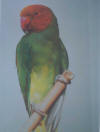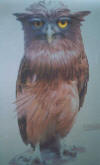|
|
the-south-asian.com January 2005 |
|
|||
|
January
2005 Archaeology
Fashion
Designers Books Between
Heaven and Hell
|
|
||||
|
Bird Trade by Gyan Marwah
The Indian Wildlife Protection Act (WPA) of 1972, prohibits hunting and trading of all Indian birds, excluding those listed as vermin. In 1990, a ban was imposed on the export of live birds from India and a year later local trade in birds was also banned. Curiously, there is no restriction on the domestic sale of exotic Indian species bred in captivity. And this is where the law is being brazenly flouted. Trappers have devised ingenious ways of camouflaging birds in myriad colours to make them look exotic and then pass them off as captive-bred exotic birds. Protected species listed in the Wildlife (Protection) Act, 1972 are often traded locally or exported out of India under false names by camouflaging them with dyes. Till a few years ago, Green Munias or Avadavats were exported mixed with a flock of dyed female Red Muniah or were declared as exotic "Tiger Finch'. The trade in Hill Mynas may be banned but the buyer is often duped into accepting Bank Mynas or Common Mynas meticulously dyed to look like their hill counterparts. Similarly, trade in Green Munias is banned but Red Munias, whose trade is permitted, provide an excellent cover for smuggling of Green Munias. It is difficult to distinguish the green from the red as both have a red bill, red iris and a black tail.
Roseringed and Alexandrine Parakeets are coloured jet black and sold as mutations, which fetch a high price. However, fake parakeets are easy to identify. Though their colour may not come out easily, but if a feather is plucked, the under skin would still be white. Indian Lorikeets or Vernal Hanging Parrots are often sold as the highly prized Abyssinian Lovebirds, a species uncommon in India which fetches an enormous price. High Prices Canaries are found in many varieties in the bird markets. The lizard variety of the Canary is palmed off as its look-alike Himalayan Green Finch which fetches high prices.
With the illegal trade taking on such proportions it wasn’t long before wildlife enthusiasts started ringing alarm bells. But the problem of the law enforcement agencies was that sometimes they too could not identify the species. Deciding to put an end to ambiguity, the Ministry of Environment and Forests contacted Traffic India—an agency hosted by the WWF India office, with the aim of monitoring wildlife trade and other forms of utilisation of animals and plants and their derivatives in India. The ministry asked it to prepare an identification booklet for the enforcement staff. The result was a benchmark study, Fraudulence in Indian Live Bird Trade which listed ways and means by which birds can be identified despite their camouflage. Extensive Trapping The booklet reveals that there are around 250 ordinary birds and 70 exotic species that are in demand. However, some species are more popular and there is a specific demand for them resulting in extensive trapping. The bulk of the trade is in parakeets and munias since they are the most frequently encountered species and are found practically in all regions. The Roseringed species in parakeets and the Blackheaded species among munias have traditionally dominated the trade and are most in demand. The popularity of a bird depends on its utility. There are seven different purposes for which birds are captured. These include keeping them as pets, for food, sports, medicinal, zoological and sorcery purposes. Amazingly the seventh reason for high demand of some species is for releasing them at VIP functions. But since most of these 'in-demand' birds come in the banned category, trappers resort to devious ways - camouflaging being one of them. Bird trading through camouflaging is a recent trade and it has risen alarmingly. Traders are using dangerous dyes to make normal birds look like exotic ones whose trade is not banned, says the report. The report is helping enforcement authorities to detect precious birds and counter illegal trading. But whether the law enforcers actually get down to studying the identification of birds and identifying the real from the fake is something which remains to be seen. *****
|
|||||
|
Copyright © 2000 - 2005 [the-south-asian.com]. Intellectual Property. All rights reserved. |
|||||



